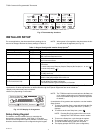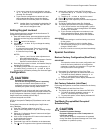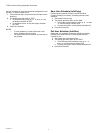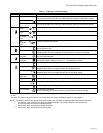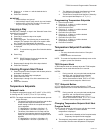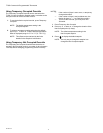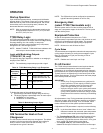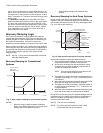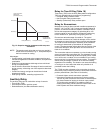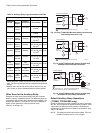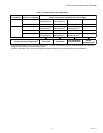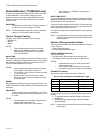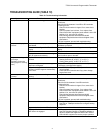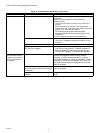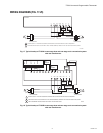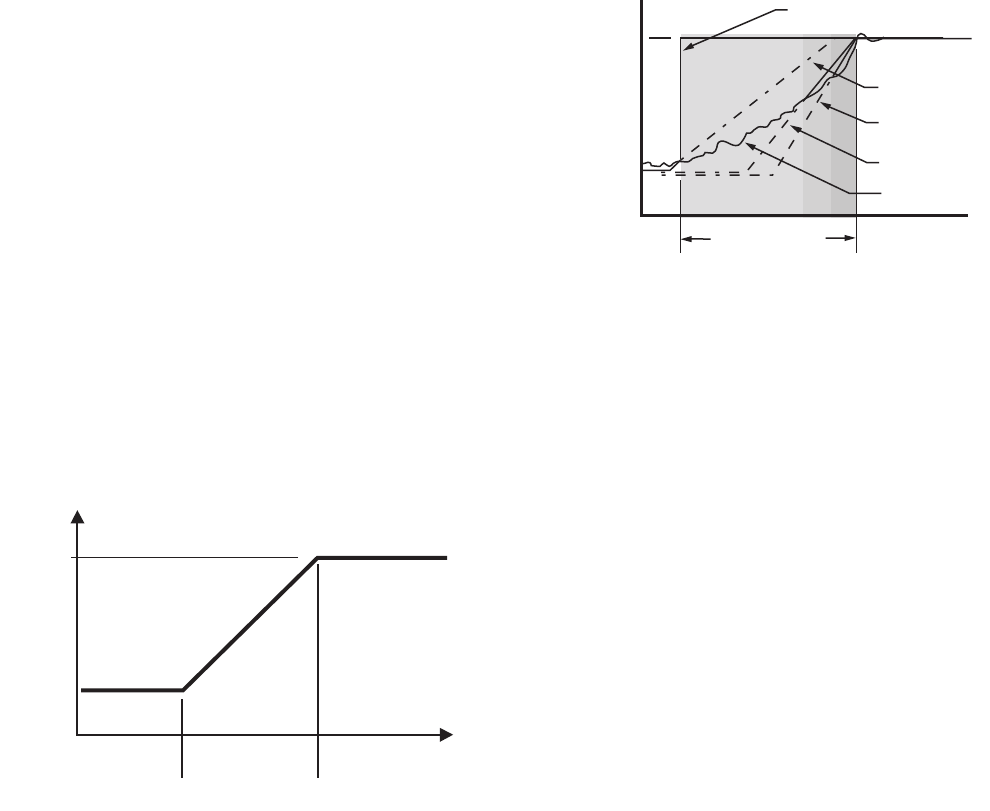
T7350 Commercial Programmable Thermostat
63-2605—06
20
signal. Error-over-time has two components making up its
value: amount of time the error exists; and size of the error.
The higher the IT, the slower the control response. In other
words, a decrease in IT causes a more rapid change to the
output signal.
—The Derivative Time (DT), also called Derivative Gain,
determines the impact of the error rate on the output signal.
The error rate is how fast the error value changes. It can
also be the direction the space temperature is going, either
toward or away from the setpoint, and its speed—rapid or
slow. A decrease in DT causes, for a given error rate, a
greater effect on output signal.
Recovery Ramping Logic
The T7350 incorporates a ramping feature that gradually
changes the space setpoints. During recovery operation, the
setpoint changes at a rate in degrees per hour depending on
the outdoor air temperature. If there is no outdoor air
temperature sensor available, the minimum ramp rate is used.
When recovering in heating, the control point raises gradually,
maximizing the use of the more economical first stage heat to
bring the sensed temperature to the desired comfort setpoint.
This minimizes using the typically more expensive later
stage(s) of heat.
NOTE: See Fig. 11 for a pictorial representation of the heat
ramp rate determination.
Recovery Ramping for Conventional
Systems
Fig. 11. Heat setpoint ramping for conventional systems.
NOTES:
— Recovery ramping applies between scheduled
heat or cool setpoint changes from not occupied to
standby and not occupied to occupied.
— Other setpoint changes use a setpoint step
change.
Recovery Ramping for Heat Pump Systems
During recovery with heat pump equipment, the heating
setpoint is split into a heat pump setpoint for compressors, and
two auxiliary heat setpoints for the auxiliary heat stages. (See
Fig. 12 for the various setpoints.)
Fig. 12. Heat setpoint ramping for heat pump systems.
Heat pump ramping for heating proceeds as follows:
1. The heat pump setpoint begins to ramp until the room
temperature and the compressor ramp intersect.
2. At this point, the heat pump setpoint performs a step
change to the Occupied (or Standby) setpoint and all
auxiliary heat stages are disabled.
NOTE: The heat pump setpoint remains here for the
rest of the Not Occupied period.
3. The stage one auxiliary heat ramp is calculated based on
a steeper slope starting 1° F (0.5° C) below the not occu-
pied setpoint.
4. When the room temperature intersects this auxiliary heat
ramp, the first stage of auxiliary heat is enabled.
5. The stage two auxiliary heat ramp is calculated based on
an even steeper slope starting 2° F (1° C) below the not
occupied setpoint.
6. When the room temperature intersects this auxiliary heat
ramp, the second stage of auxiliary heat is enabled.
During the cool recovery period, the setpoint changes at a rate
in degrees per hour relative to the outdoor air temperature. If
there is no outdoor air temperature sensor available, the
minimum ramp rate is used.
See Fig. 13 for the various setpoints.
NOTE: For cooling, the same method is used in both
conventional and heat pump systems.
HEAT RECOVERY
RAMP RATE
(DEGREES/HOUR)
MaxHtRamp
MinHtRamp
OaTempMinHtRamp OaTempMaxHtRamp
OUTDOOR AIR
TEMPERATURE
M10109A
AUX HEAT
STAGE 1 RAMP
NORMAL
RECOVERY RAMP
OCCUPIED
SETPOINT
NOT OCCUPIED
SETPOINT
M19877
RECOVERY TIME
OCCUPIED
TIME
AUX HEAT
STAGE 2 RAMP
HEAT PUMP SETPOINT
(FOR COMPRESSORS)
SPACE
TEMPERATURE



